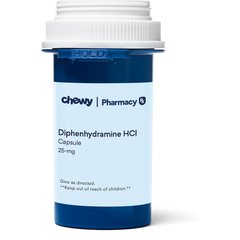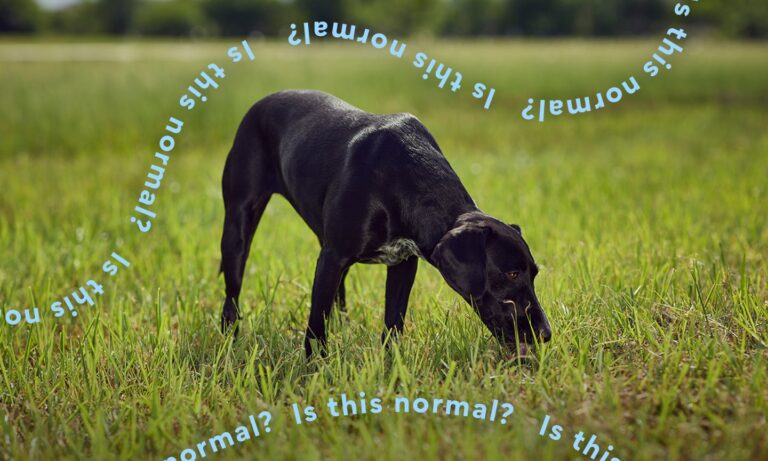How Much Benadryl® Can I Give My Dog? Is It Safe?

Photo by iStock.com/Ksenia Raykova
This content was reviewed by a veterinary professional to answer your most common questions about this topic. This content shouldn’t take the place of advice by your vet. No writer or qualified reviewer has received any compensation from the manufacturer of any medication as part of creating this article.
Benadryl® is a go-to, over-the-counter antihistamine for many of us pet parents when we’re suffering from pesky seasonal allergies, but did you know you can give your dog this human medication too?
Learn the ins and outs of Benadryl® for dogs, including when it’s appropriate to give a dog Benadryl®, how it can help your pet, how much you can safely give your pup, and more.
Consult your veterinarian before giving your pet Benadryl® or any other medication. Your vet can assist with appropriate dosage amounts and provide guidance on managing your dog’s symptoms.
Is Benadryl® Safe for Dogs? Can I Give My Dog Benadryl®?
Yes, Benadryl® is generally safe for dogs—with a vet’s approval and when given in appropriate dosages.
However, there are certain dogs who should not be given Benadryl®, including pregnant dogs and dogs with the following conditions:
What Does Benadryl® Treat in Dogs?
Benadryl® has a number of uses for dogs. The three most associated with Benadryl® include:
- Allergies: Even though Benadryl® is typically only effective in 7% of dog allergy cases, your vet may recommend Benadryl® to help ease allergy symptoms before escalating to prescription medications and other treatment options.
- Motion sickness: Veterinarians may also recommend Benadryl® to reduce nausea and vomiting associated with motion sickness.
- Anxiety: As for anxiety, including travel anxiety and anxiety due to fireworks or thunderstorms, Benadryl® isn’t as effective—so it’s best talk with your vet, who can recommend the best treatment. In the case of anxiety, prescription and over-the-counter medication usually isn’t the first-line treatment. Do not diagnose and treat dogs on your own.
The following are health conditions your dog could have that you may consider treating with Benadryl®, with your vet’s approval:
- Allergic reactions to insect bites
- Allergic reactions to insect stings
- Allergic reactions to snake bites
- Allergic reactions of unknown causes
- Itchiness from skin allergies/itchy skin
- Environmental allergies
- Seasonal allergies
- Food allergies
- Swelling/inflammation
- Hives
- Runny nose
- Watery or runny eyes
- Coughing
- Sneezing
- Motion sickness (Benadryl® can cause drowsiness)
- Mast cell tumors (Benadryl® helps mitigate histamine-release effects)
- Used with certain medications or vaccines to prevent allergic reactions
Seek your vet’s advice before giving your dog Benadryl®. Your vet needs to determine the underlying health condition causing the symptom(s), so they know whether Benadryl® is an appropriate treatment.
For example, you may think your dog’s goopy, red eyes are simply a case of seasonal allergies, but goopy, red eyes are also a symptom of dry eyes or even a health condition that affects the eyes called glaucoma. Benadryl® won’t help either of those, and the actual problem would remain untreated and get worse if you go straight to the antihistamine.
What Kind of Benadryl® Should I Give My Dog?
Benadryl® comes in several forms:
- Benadryl® tablets
- Benadryl® chewable tablets
- Children’s liquid Benadryl®
- Liqui-gel Benadryl® capsules
One form isn’t necessarily superior to another, says Jason Dombrosky, DVM, medical director at VEG in San Ramon, California.
However, always read the ingredients. Some forms, including generics, contain additives that are harmful to dogs. Xylitol, an artificial sweetener, is one example of a dangerous additive. It’s toxic to dogs, so pet parents should always ensure anything they give a dog doesn’t contain it.
Generic forms of Benadryl® with only diphenhydramine as the main active ingredient are just as effective as the brand name. The main difference between brand name and generic is generic forms are generally less expensive and are often sold under various store brand names.
Recommended Product
How Much Benadryl® Can I Give My Dog?
What’s the correct Benadryl® dosage for dogs? And how often can I give my dog Benadryl®?
It’s extremely important to give your dog the correct dosage of Benadryl®. Your vet will let you know the correct dosage for your pet.
The appropriate dosage of Benadryl® for dogs is determined by your dog’s weight. The Merck Veterinary Manual states that for every 1 kilogram (or 2.2 pounds) of body weight, you can give your dog 2–4 mgs of diphenhydramine.
An easier way to look at it, especially for small dogs: The correct dosage is roughly 1–2 mg of Benadryl® per 1 pound of body weight. So, a 10-pound dog would receive about 10 mg.
Liquid Benadryl®, on the other hand, contains 12.5 mg/5 ml (or 2.5 mg/ml). So, to determine liquid dosage, you’d divide your dog’s weight in pounds by 2.5. A 10-pound dog, for example, would receive 4 ml.
Again, your vet will tell you the correct dosage for your pet.
Benadryl® for Dogs Dosage Chart
| Dog’s weight | Benadryl® tablets | Liquid Benadryl® (12.5 mg/5 ml) |
|---|---|---|
| 10 pounds | 10 mg | 4 ml |
| 20 pounds | 20 mg | 8 ml |
| 30 pounds | 30 mg | 12 ml |
| 40 pounds | 40 mg | 16 ml |
| 50 pounds | 50 mg | 20 ml |
| 60 pounds | 60 mg | 24 ml |
| 70 pounds | 70 mg | 28 ml |
| 80 pounds | 80 mg | 32 ml |
| 90 pounds | 90 mg | 36 ml |
| 100 pounds | 100 mg | 40 ml |
How Often Can I Give My Dog Benadryl®?
You can safely give your dog two to three doses of Benadryl® during each 24-hour period, as long as you’re following the guidelines for the correct dosage.
Follow your vet’s advice.
What Are the Side Effects of Benadryl® for Dogs?
As with all medications, there are potential side effects when using Benadryl® for dogs. They include:
Common side effects:
- Drowsiness
- Dry mouth
- Urinary retention
Less common side effects:
- Behavioral changes
- Gastrointestinal issues
- Increased heart rate
How To Spot a Benadryl® Overdose
Additionally, it’s possible for your dog to experience a Benadryl® overdose if the Benadryl® dosage guidelines aren’t carefully followed.
Signs of a Benadryl® overdose in dogs include:
Central nervous system (CNS):
- Agitation
- Excessive excitement
- Seizures
- Pronounced sedation
Gastrointestinal:
- Diarrhea
- Vomiting
- Constipation
Cardiovascular:
- Abnormal blood pressure
- Abnormal heart rate
If you suspect your pet may have experienced an overdose of Benadryl®, please immediately contact your veterinarian or an animal poison control center such as Pet Poison Helpline® at 855-764-7661. Consultation fees often apply.
FAQs About Benadryl® for Dogs
Does Benadryl® make dogs sleepy?
Yes, Benadryl® can make dogs sleepy. Benadryl® is a mild sedative. However, sometimes pets will have the opposite reaction and become agitated or hyperactive. Please contact your vet if you have any concerns about your pet’s response to the medication.
Will Benadryl® help my dog stop coughing?
Benadryl® may help alleviate allergy symptoms, but it may not be effective for stopping your dog’s coughing. Speak with your vet, who can recommend the best course of action.
Is Benadryl® or Zyrtec® better for dogs?
For allergic reactions, most vets will reach for Benadryl®. However, for treatment of seasonal allergies, Zyrtec® has been more effective (15%) than Benadryl® (at only 6.7%).
Should a pet parent use children’s Benadryl® or regular Benadryl®?
Either is fine, but pet parents must be aware of the concentration, ingredients, and correct dosages.
This content was medically reviewed by Veronica Higgs, DVM, Chewy veterinarian.













